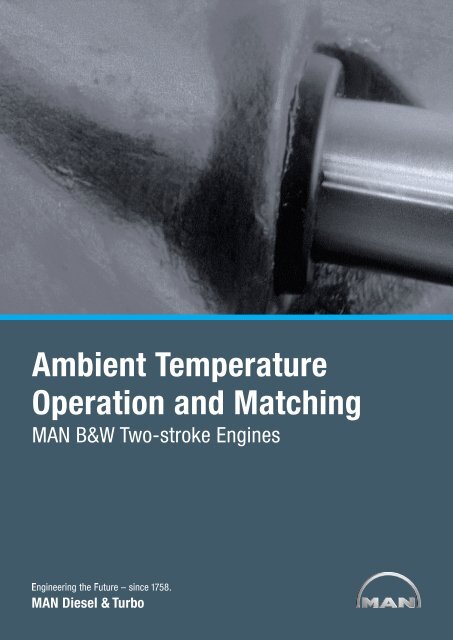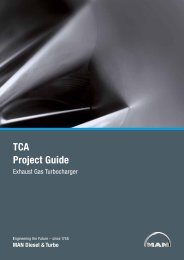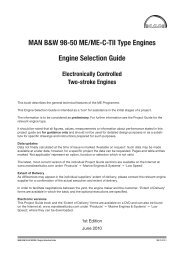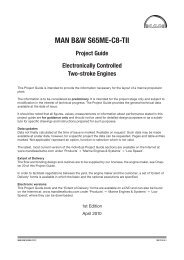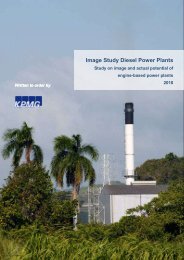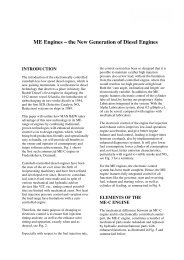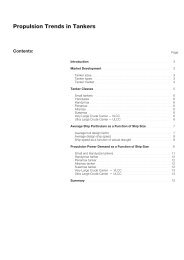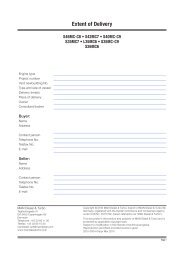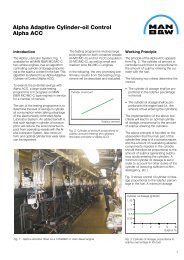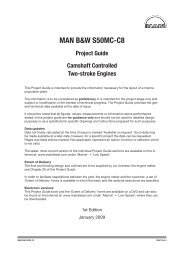Ambient Temperature Operation and Matching - MAN Diesel & Turbo
Ambient Temperature Operation and Matching - MAN Diesel & Turbo
Ambient Temperature Operation and Matching - MAN Diesel & Turbo
You also want an ePaper? Increase the reach of your titles
YUMPU automatically turns print PDFs into web optimized ePapers that Google loves.
<strong>Ambient</strong> <strong>Temperature</strong><br />
<strong>Operation</strong> <strong>and</strong> <strong>Matching</strong><br />
<strong>MAN</strong> B&W Two-stroke Engines
Content<br />
<strong>MAN</strong> B&W <strong>Diesel</strong><br />
Introduction ................................................................................................5<br />
St<strong>and</strong>ard ambient temperature matched engine ............................................5<br />
St<strong>and</strong>ard unrestricted service dem<strong>and</strong>s ...................................................5<br />
Operating at high seawater temperature with st<strong>and</strong>ard matched engine ...6<br />
Non-st<strong>and</strong>ard ambient temperature matched engine .....................................7<br />
Engine matching for non-st<strong>and</strong>ard air temperature conditions ..................7<br />
Engine matching for high tropical seawater temperature conditions ..........8<br />
Design recommendations for operation at extremely low air temperature ....... 10<br />
Main precautions for extreme low air temperature operation .................. 10<br />
Other low temperature precautions ....................................................... 11<br />
Increased steam production in wintertime .............................................. 12<br />
Closing remarks ......................................................................................... 12<br />
<strong>Ambient</strong> <strong>Temperature</strong> <strong>Operation</strong> <strong>and</strong> <strong>Matching</strong><br />
3
<strong>Ambient</strong> <strong>Temperature</strong> <strong>Operation</strong> <strong>and</strong> <strong>Matching</strong><br />
<strong>MAN</strong> B&W Two-stroke Engines<br />
Introduction<br />
All diesel engines that are used as<br />
prime movers on ships are exposed<br />
to the varying local climatic conditions<br />
that prevail throughout the world.<br />
In some areas, the ambient sea <strong>and</strong><br />
air temperatures can, occasionally,<br />
be extremely high. Likewise in arc-<br />
tic areas, the temperatures can be<br />
very low. Under both extreme tem-<br />
perature conditions some engine de-<br />
sign precautions might be necessary<br />
to enable the engine to operate in unre-<br />
stricted service.<br />
This paper will outline operation possi-<br />
bilities with a st<strong>and</strong>ard matched engine<br />
in any extreme temperature environ-<br />
ment <strong>and</strong> describe the possibilities for<br />
special matching of engines for more<br />
permanent operation under such con-<br />
ditions.<br />
<strong>MAN</strong> B&W <strong>Diesel</strong><br />
St<strong>and</strong>ard ambient temperature<br />
matched engine<br />
St<strong>and</strong>ard unrestricted service<br />
dem<strong>and</strong>s<br />
For a st<strong>and</strong>ard main engine, the en-<br />
gine layout is based on the ambient<br />
reference conditions of the Interna-<br />
tional St<strong>and</strong>ard Organization (ISO):<br />
ISO 3046-1:2002(E) <strong>and</strong><br />
ISO 15550:2002(E):<br />
ISO ambient reference conditions<br />
Barometric pressure: 1,000 mbar<br />
<strong>Turbo</strong>charger air intake<br />
temperature:<br />
Charge air coolant temperature:<br />
25ºC<br />
25ºC<br />
Relative air humidity: 30%<br />
With this layout basis, the engine must<br />
be able to operate in unrestricted serv-<br />
ice, i.e. up to 100% Specified Maximum<br />
Continuous Rating (SMCR), within the<br />
typical ambient temperature range that<br />
the ship is exposed to, operating from<br />
tropical to low winter ambient condi-<br />
tions.<br />
According to the International Associa-<br />
tion of Classification Societies (IACS)<br />
rule M28, the upper requirement, nor-<br />
mally referred to as tropical ambient ref-<br />
erence conditions, is as follows:<br />
IACS M28 (1978):<br />
Tropical ambient reference conditions<br />
Barometric pressure: 1,000 mbar<br />
Air temperature: 45ºC<br />
Seawater temperature: 32ºC<br />
Relative air humidity: 60%<br />
The above tropical ambient relative hu-<br />
midity of 60% at 45ºC is theoretically<br />
the absolute limit at which it is possible<br />
for humans to survive. The correspon-<br />
ding wet bulb temperature is 36.8ºC.<br />
<strong>MAN</strong> <strong>Diesel</strong> has never measured levels<br />
above 50% at 45ºC, <strong>and</strong> humidity le-<br />
vels above st<strong>and</strong>ard tropical ambient<br />
conditions will never occur.<br />
When applying the central cooling wa-<br />
ter system which, today, is more com-<br />
monly used than the seawater system,<br />
the corresponding central cooling wa-<br />
ter/scavenge air coolant temperature is<br />
4ºC higher than the seawater tempera-<br />
ture, i.e. equal to 36ºC.<br />
The winter ambient reference condi-<br />
tions used as st<strong>and</strong>ard for <strong>MAN</strong> B&W<br />
two-stroke engines are as follows:<br />
Winter ambient reference conditions<br />
Barometric pressure: 1,000 mbar<br />
<strong>Turbo</strong>charger air intake<br />
temperature:<br />
Cooling water temperature:<br />
(minimum for lub. oil cooler)<br />
<strong>Ambient</strong> <strong>Temperature</strong> <strong>Operation</strong> <strong>and</strong> <strong>Matching</strong><br />
10ºC<br />
10ºC<br />
Relative air humidity: 60%<br />
Shipyards often specify a constant<br />
(maximum) central cooling water tem-<br />
perature of 36°C, not only for tropical<br />
ambient conditions, but also for winter<br />
ambient conditions. The purpose is to<br />
reduce the seawater pump flow rate<br />
when possible, <strong>and</strong> thereby to reduce<br />
the electric power consumption, <strong>and</strong>/or<br />
to reduce the water condensation in the<br />
air coolers.<br />
However, when operating with 36°C<br />
cooling water instead of for example<br />
10°C (to the scavenge air cooler), the<br />
5
SFOC<br />
g/kWh<br />
specific fuel oil consumption (SFOC)<br />
will increase by approx. 2 g/kWh, see<br />
Fig. 1. Any obtained gain in reduced<br />
electric power consumption, therefore,<br />
will be more than lost in additional fuel<br />
costs of the main engine.<br />
The above ISO, tropical <strong>and</strong> win-<br />
ter ambient reference conditions are<br />
used by <strong>MAN</strong> <strong>Diesel</strong> for ships, <strong>and</strong><br />
<strong>MAN</strong> B&W two-stroke engines com-<br />
ply with the above rules. <strong>MAN</strong> B&W<br />
engines matched according to the<br />
above rules are able to operate con-<br />
tinuously up to 100% SMCR in the<br />
air temperature range between about<br />
-10 <strong>and</strong> 45ºC.<br />
Often the engine room temperature is<br />
mistaken for being equal to the turbochar-<br />
ger air intake temperature. However, since<br />
the air ventilation duct outlets for a nor-<br />
mal air intake system are placed near<br />
the turbochargers, the air inlet tempe-<br />
rature to the turbochargers will be very<br />
close to the ambient outside air tem-<br />
perature. Under normal air temperature<br />
conditions, the air inlet temperature to<br />
the turbocharger is only 1-3°C higher<br />
than the ambient outside air tempera-<br />
ture.<br />
<strong>Turbo</strong>charger air intake temperature: 10°C<br />
2 g/kWh<br />
Fig. 1: Influence on SFOC of the cooling water<br />
(scavenge air coolant) temperature<br />
36°C C.W<br />
10°C C.W<br />
40 50 60 70 80 90 100% SMCR<br />
Engine shaft power<br />
6 <strong>Ambient</strong> <strong>Temperature</strong> <strong>Operation</strong> <strong>and</strong> <strong>Matching</strong><br />
The classification society rules often<br />
specify an engine room air temperature<br />
of 0-55ºC as the basis for the design<br />
of the engine room components. The<br />
55ºC is the temperature used when<br />
approving engine room components.<br />
This, however, must not be mistaken<br />
for the above air intake temperature of<br />
45ºC specified when related to the ca-<br />
pacity or effect of the machinery.<br />
In recent years, owners/shipyards have<br />
sometimes required unrestricted service<br />
on special maximum ambient tempera-<br />
tures higher than the tropical ambient<br />
temperatures specified by IACS M28.<br />
In such cases, the main engine has to<br />
be special high temperature matched,<br />
as described later in this paper.<br />
Furthermore, operation in arctic areas with<br />
extremely low air temperatures has also<br />
sometimes been required by owners/<br />
shipyards, <strong>and</strong> the measures to be taken<br />
are also described later in this paper.<br />
Operating at high seawater tempera-<br />
ture with st<strong>and</strong>ard matched engine<br />
An increase of the seawater tempera-<br />
ture <strong>and</strong>, thereby, the scavenge air<br />
temperature has a negative impact on<br />
the heat load conditions in the combus-<br />
tion chamber. Therefore, all <strong>MAN</strong> B&W<br />
two-stroke engines for marine applica-<br />
tions have an alarm set point of 55°C<br />
for the scavenge air temperature for pro-<br />
tection of the engine, as described later.<br />
For a st<strong>and</strong>ard ambient temperature<br />
matched engine operating at an in-<br />
creased seawater temperature existing<br />
in some inl<strong>and</strong>, gulf, bay <strong>and</strong> harbour<br />
areas, the maximum power output of<br />
the engine should be reduced to an<br />
engine load resulting in a scavenge air<br />
temperature below the level of the scav-<br />
enge air temperature alarm.<br />
Nevertheless, the engine’s obtainable<br />
load level will in all cases be much higher<br />
than required to ensure a safe manoeu-<br />
vrability (4-6 knots) of the ship even at<br />
an extreme seawater temperature of for<br />
example 42°C.<br />
When sailing in, for example, the har-<br />
bour area during manoeuvring, the en-<br />
gine load will normally be relatively low<br />
(15-30% SMCR), <strong>and</strong> the corresponding<br />
scavenge air temperature will then only<br />
be slightly higher than the scavenge air<br />
coolant temperature. Therefore, a sea-<br />
water temperature as high as for exam-<br />
ple 42°C in harbour areas is not con-<br />
sidered a problem for the main engine,<br />
<strong>and</strong> a special temperature matching is<br />
not needed under these operating con-<br />
ditions<br />
In general, when sailing in areas with a<br />
high seawater temperature, it is pos-<br />
sible to operate the st<strong>and</strong>ard ambient<br />
temperature matched main engine at<br />
any load as long as the scavenge air<br />
temperature alarm limit is not reached.<br />
If the alarm is activated, the engine load<br />
has to be reduced.
Non-st<strong>and</strong>ard ambient temperature<br />
matched engine<br />
If unrestricted loads are desired in a<br />
temperature range different from the<br />
st<strong>and</strong>ard, different matching possibili-<br />
ties are available.<br />
<strong>Turbo</strong>charger<br />
air intake temperature<br />
65<br />
60<br />
55<br />
50<br />
45<br />
40<br />
35<br />
30<br />
25<br />
20<br />
15<br />
10<br />
5<br />
0<br />
-5<br />
-10<br />
-15<br />
-20<br />
-25<br />
-30<br />
-35<br />
-40<br />
-45<br />
-50<br />
Max.<br />
Special<br />
design<br />
temperature<br />
Special<br />
Low temperature<br />
matched engine<br />
Min.<br />
<strong>MAN</strong> B&W <strong>Diesel</strong><br />
Special<br />
tropical<br />
temperature<br />
ISO based<br />
design<br />
layout<br />
Lowest<br />
ambient air<br />
temperature<br />
Engine matching for non-st<strong>and</strong>ard<br />
air temperature conditions<br />
Usually, higher or lower turbocharger air<br />
intake temperatures may result in lower<br />
or higher scavenge air pressures, re-<br />
spectively, <strong>and</strong> vice versa.<br />
Max.<br />
45 °C<br />
St<strong>and</strong>ard<br />
design<br />
<strong>Temperature</strong><br />
ISO<br />
25 °C<br />
Min.<br />
-10 °C<br />
St<strong>and</strong>ard<br />
ISO temperature<br />
matched engine<br />
Normal<br />
tropical<br />
temperature<br />
ISO<br />
design<br />
layout<br />
For engine loads<br />
higher than 30% SMCR<br />
a low scavenge air<br />
coolant temperature<br />
is recommended<br />
(Giving low SFOC <strong>and</strong><br />
low scav. air press.)<br />
Normal min.<br />
ambient air<br />
temperature<br />
Possible low ambient<br />
air temperature<br />
exhaust gas bypass for<br />
operation under<br />
extremely low ambient<br />
temperature conditions<br />
Fig. 2: Principles for st<strong>and</strong>ard <strong>and</strong> special high (or low) ambient air temperature matched engines<br />
An increase of, for example, 5ºC of the<br />
tropical air temperature from st<strong>and</strong>ard<br />
45ºC to special 50ºC will result in a too<br />
low scavenge air pressure at 50ºC.<br />
Max.<br />
Special<br />
design<br />
temperature<br />
Special<br />
High temperature<br />
matched engine<br />
Min.<br />
Special<br />
tropical<br />
temperature<br />
ISO based<br />
design<br />
layout<br />
Low ambient air<br />
temperature exhaust<br />
gas bypass will be<br />
needed below min.<br />
temperature<br />
Up to 100% SMCR running is not allowed<br />
Up to 100% SMCR running is allowed<br />
Lowest<br />
ambient air<br />
temperature<br />
Up to 100% SMCR running only allowed when low<br />
ambient temperature exhaust gas bypass (C1+2)<br />
is installed<br />
<strong>Ambient</strong> <strong>Temperature</strong> <strong>Operation</strong> <strong>and</strong> <strong>Matching</strong><br />
7
However, the pressure reduction can<br />
be compensated for by specifying a<br />
correspondingly higher (turbocharger)<br />
scavenge air pressure at ISO ambient<br />
reference conditions. This involves that<br />
the engine, instead of being matched<br />
for the ISO-based design air temperature<br />
of 25ºC, has to be matched for the<br />
25 + 5 = 30ºC turbocharger air intake<br />
temperature.<br />
The original ISO-based heat load conditions<br />
will then almost be obtained for<br />
this higher design air temperature. The<br />
principles for st<strong>and</strong>ard <strong>and</strong> special high<br />
ambient air temperature matched engines<br />
are shown in Fig. 2.<br />
St<strong>and</strong>ard 55 °C<br />
St<strong>and</strong>ard 48 °C<br />
St<strong>and</strong>ard 36 °C<br />
St<strong>and</strong>ard 32 °C<br />
St<strong>and</strong>ard<br />
basis 25 °C<br />
<strong>Temperature</strong> °C<br />
56<br />
54<br />
52<br />
50<br />
48<br />
46<br />
44<br />
42<br />
40<br />
38<br />
36<br />
34<br />
32<br />
30<br />
28<br />
26<br />
24<br />
22<br />
Maximum<br />
scavenge air<br />
temperature<br />
at 100% SMCR<br />
St<strong>and</strong>ard<br />
tropical<br />
scavenge air<br />
coolant<br />
temperature<br />
St<strong>and</strong>ard tropical<br />
seawater<br />
temperature<br />
ISO based<br />
scavenge air<br />
coolant<br />
temperature<br />
St<strong>and</strong>ard ISO temperature<br />
matched engine<br />
St<strong>and</strong>ard air cooler design<br />
8 <strong>Ambient</strong> <strong>Temperature</strong> <strong>Operation</strong> <strong>and</strong> <strong>Matching</strong><br />
At the other end of the air temperature<br />
range, the increase of 5ºC of the design<br />
air intake temperature will involve<br />
a too high scavenge air pressure when<br />
operating at -10ºC. <strong>Operation</strong> below<br />
-10 + 5 = -5ºC will then only be possible<br />
when installing a variable exhaust gas<br />
bypass valve system for low air temperatures,<br />
as described later.<br />
Fig. 2 may in a similar way also be<br />
used to explain a special low temperature<br />
matched engine. For example, if<br />
the st<strong>and</strong>ard tropical air temperature<br />
needed is reduced by 10ºC, from 45ºC<br />
to 35ºC, the engine matching design air<br />
temperature can be reduced to 25 -10<br />
= 15ºC.<br />
ISO<br />
design<br />
layout<br />
Maximum<br />
scavenge air<br />
temperature<br />
at 100% SMCR<br />
High tropical<br />
scavenge air<br />
coolant<br />
temperature<br />
High tropical<br />
seawater<br />
temperature<br />
High scavenge<br />
air coolant<br />
temperature<br />
Special high temperature<br />
matched engine<br />
Special air cooler design<br />
Scavenge air temperature limit Scavenge air temperature limit<br />
ISO based<br />
design<br />
layout<br />
Max. 55 °C<br />
Max. 48 °C<br />
Max. 40 °C<br />
Max. 36 °C<br />
Max. 29 °C<br />
This involves that the exhaust gas temperature<br />
will increase by about 16ºC<br />
compared with a st<strong>and</strong>ard ISO temperature<br />
matched engine, whereas the<br />
SFOC will increase.<br />
Engine matching for high tropical<br />
seawater temperature conditions<br />
For long time operation in an area with<br />
high tropical seawater temperatures,<br />
the following should be observed.<br />
An increase in the seawater temperature<br />
<strong>and</strong>, thereby, of the scavenge air<br />
coolant temperature will involve a similar<br />
increase in the scavenge air temperature,<br />
which has a negative impact on<br />
the combustion chamber temperatures.<br />
Up to 100% SMCR running is<br />
not allowed (scavenge air)<br />
Up to 100% SMCR running is<br />
allowed (scavenge air)<br />
Up to 100% SMCR running is<br />
allowed (scavenge air coolant/central<br />
cooling water)<br />
Up to 100% SMCR running is<br />
allowed (seawater)<br />
Fig. 3: Principles for layout of scavenge air cooler for st<strong>and</strong>ard <strong>and</strong> special high scavenge air coolant temperature (illustrated for a central cooling water system)
Therefore, for all marine applications, an<br />
alarm set point of 55ºC for the scavenge<br />
air temperature is applied for protection<br />
of the engine.<br />
The st<strong>and</strong>ard marine scavenge air cooler<br />
is specified with a maximum 12ºC tem-<br />
perature difference between the cooling<br />
water inlet <strong>and</strong> the scavenge air outlet<br />
at 100% SMCR, which gives a maxi-<br />
mum scavenge air temperature of 36 +<br />
12 = 48ºC for the scavenge air cooler<br />
layout <strong>and</strong>, accordingly, a margin of 7ºC<br />
to the scavenge air temperature alarm<br />
limit of 55ºC.<br />
A temperature difference of 8ºC is con-<br />
sidered to be the lowest possible tem-<br />
perature difference to be used for a<br />
realistic specification of a scavenge air<br />
cooler. Accordingly, the 48 - 8 = 40ºC is<br />
the maximum acceptable scavenge air<br />
coolant temperature for a central cool-<br />
ing water system, see the principles for<br />
layout of the scavenge air cooler in Fig. 3.<br />
The dem<strong>and</strong> for an increased tropi-<br />
cal scavenge air coolant (central cool-<br />
ing water) temperature of up to 40ºC,<br />
therefore, can be compensated for by a<br />
reduced design temperature difference<br />
of the scavenge air cooler. This can be<br />
obtained by means of an increased wa-<br />
ter flow <strong>and</strong>/or a bigger scavenge air<br />
cooler.<br />
<strong>MAN</strong> B&W <strong>Diesel</strong><br />
<strong>Ambient</strong> <strong>Temperature</strong> <strong>Operation</strong> <strong>and</strong> <strong>Matching</strong><br />
9
Design recommendations for operation<br />
at extremely low air temperature<br />
When a st<strong>and</strong>ard ambient temperature<br />
matched main engine on a ship occa-<br />
sionally operates under arctic condi-<br />
tions with low turbocharger air intake<br />
temperatures, the density of the air will<br />
be too high. As a result, the scavenge<br />
air pressure, the compression pressure<br />
<strong>and</strong> the maximum firing pressure will be<br />
too high.<br />
In order to prevent such excessive pres-<br />
sures under low ambient air tempera-<br />
ture conditions, the turbocharger air in-<br />
let temperature should be kept as high<br />
as possible (by heating, if possible).<br />
Scavenge<br />
air receiver<br />
Exhaust gas<br />
receiver<br />
<strong>Diesel</strong> engine<br />
10 <strong>Ambient</strong> <strong>Temperature</strong> <strong>Operation</strong> <strong>and</strong> <strong>Matching</strong><br />
B<br />
D2<br />
Exhaust gas bypass<br />
D1<br />
However, for an inlet air temperature<br />
below approx. -10ºC, some engine de-<br />
sign precautions have to be taken.<br />
Main precautions for extreme low air<br />
temperature operation<br />
With a load-dependent exhaust gas by-<br />
pass system (st<strong>and</strong>ard <strong>MAN</strong> <strong>Diesel</strong> rec-<br />
ommendation for extreme low air tem-<br />
perature operation), as shown in Fig. 4,<br />
1<br />
Furthermore, the scavenge air coo-<br />
lant (cooling water) temperature<br />
should be kept as low as possible<br />
<strong>and</strong>/or the engine power in service<br />
should be reduced.<br />
2<br />
C1+2<br />
Scavenge<br />
air cooler<br />
B Exhaust gas bypass valve<br />
Controlled by the scavenge air pressure<br />
C1+2 Control device<br />
Ensures that the load dependent scavenge air<br />
pressure does not exceed the corresponding<br />
ISO-based pressure<br />
Fig. 4: St<strong>and</strong>ard load-dependent low ambient air temperature exhaust gas bypass system<br />
Turbine<br />
<strong>Turbo</strong>charger<br />
Compressor<br />
part of the exhaust gas bypasses the<br />
turbocharger turbine, giving less energy<br />
to the compressor, thus reducing the air<br />
supply <strong>and</strong> scavenge air pressure to the<br />
engine.<br />
For the electronically controlled ME<br />
engine (ME/ME-C/ME-B), the load-de-<br />
pendent bypass control can be incor-<br />
porated in the Engine Control System<br />
(ECS) as an add-on.<br />
Engine load, fuel index <strong>and</strong> scavenge<br />
air pressure signals are already avail-<br />
able for the ME software <strong>and</strong>, therefore,<br />
additional measuring devices are not<br />
needed for ME engines.<br />
Air intake casing<br />
Exhaust gas system<br />
D Required electric measuring device<br />
D1 Scavenge air pressure<br />
D2 Engine speed <strong>and</strong> engine load
In general, a turbocharger with a normal<br />
layout can be used in connection with<br />
an exhaust gas bypass. However, in a<br />
few cases a turbocharger modification<br />
may be needed.<br />
The exhaust gas bypass system ensures<br />
that when the engine is running at part<br />
load at low ambient air temperatures,<br />
the load-dependent scavenge air pres-<br />
sure is close to the corresponding pres-<br />
sure on the scavenge air pressure curve<br />
which is valid for ISO ambient condi-<br />
tions. When the scavenge air pressure<br />
exceeds the read-in ISO-based scaven-<br />
ge air pressure curve, the bypass valve<br />
will variably open <strong>and</strong>, irrespective of<br />
the ambient conditions, will ensure that<br />
the engine is not overloaded. At the<br />
same time, it will keep the exhaust gas<br />
temperature relatively high.<br />
The latest generations of turbochargers<br />
with variable flow, e.g. the VTA (Variable<br />
Turbine Area) system from <strong>MAN</strong> <strong>Diesel</strong>,<br />
can replace the variable bypass <strong>and</strong> en-<br />
sure, the same scavenge air pressure<br />
control.<br />
Other low temperature precautions<br />
Low ambient air temperature <strong>and</strong> low<br />
seawater temperature conditions come<br />
together. The cooling water inlet tem-<br />
perature to the lube oil cooler should<br />
not be lower than 10°C, as otherwise<br />
the viscosity of the oil in the cooler will<br />
be too high, <strong>and</strong> the heat transfer in-<br />
adequate. This means that some of the<br />
cooling water should be recirculated to<br />
keep up the temperature.<br />
Furthermore, to keep the lube oil viscos-<br />
ity low enough to ensure proper suction<br />
conditions in the lube oil pump, it may<br />
<strong>MAN</strong> B&W <strong>Diesel</strong><br />
be advisable to install heating coils near<br />
the suction pipe in the lube oil bottom<br />
tank.<br />
The following additional modifications of<br />
the st<strong>and</strong>ard design practice should be<br />
considered as well:<br />
Larger electric heaters for the cylin-<br />
der lubricators or other cylinder oil<br />
ancillary equipment<br />
Cylinder oil pipes to be further heat<br />
traced/insulated<br />
Upgraded steam tracing of fuel oil<br />
pipes<br />
Steam production<br />
kg/h<br />
2,500<br />
2,000<br />
1,500<br />
1,000<br />
500<br />
0<br />
40<br />
6S60MC-C7/ME-C7<br />
SMCR = 13,560 kW at 105 r/min<br />
Air intake temperature: 0 °C<br />
Cooling water temperature: 10°C<br />
Extra steam needed<br />
Increased preheater capacity for<br />
jacket water during st<strong>and</strong>still<br />
Different grades of lubricating oil for<br />
turbochargers<br />
Space heaters for electric motors<br />
Sea chests must be arranged so that<br />
blocking with ice is avoided.<br />
Ships with ice class notation<br />
For ships with the Finnish-Swedish ice<br />
class notation 1C, 1B, 1A <strong>and</strong> even<br />
1A super or similar, all <strong>MAN</strong> B&W<br />
two-stroke diesel engines meet the<br />
ice class dem<strong>and</strong>s, i.e. there will be no<br />
changes to the main engines.<br />
Surplus steam<br />
50 60 70 80 90 100%<br />
Total steam production,<br />
with exhaust gas bypass<br />
Total steam production,<br />
without bypass<br />
Steam consumption<br />
SMCR<br />
Engine shaft power<br />
Fig. 5: Expected steam production by exhaust gas boiler at winter ambient conditions (0 °C air) for main<br />
engine 6S60MC-C7/ME-C7 with/without a load-dependent low air temperature exhaust gas bypass system<br />
<strong>Ambient</strong> <strong>Temperature</strong> <strong>Operation</strong> <strong>and</strong> <strong>Matching</strong><br />
11
However, if the ship is with ice class<br />
notation 1A super <strong>and</strong> the main engine<br />
has to be reversed for going astern<br />
(Fixed Pitch Propeller), the starting air<br />
compressors must be able to charge<br />
the starting air receivers within half an<br />
hour, instead of one hour, i.e. the com-<br />
pressors must be the double in size<br />
compared to normal.<br />
For other special ice class notations,<br />
the engines need to be checked indi-<br />
vidually.<br />
The exhaust gas bypass system to be<br />
applied is independent of the ice class-<br />
es, <strong>and</strong> only depends on how low the<br />
specified ambient air temperature is<br />
expected to be. However, if the ship is<br />
specified with a high ice class like 1A<br />
super, it is advisable to make prepara-<br />
tions for, or install, an exhaust gas by-<br />
pass system.<br />
Increased steam production in<br />
wintertime<br />
During normal operation at low am-<br />
bient temperatures, the exhaust gas<br />
temperature after the turbochargers will<br />
decrease by about 1.6ºC for each 1.0ºC<br />
reduction of the intake air temperature.<br />
The load-dependent exhaust gas by-<br />
pass system will ensure that the exhaust<br />
gas temperature after the turbochargers<br />
will fall by only about 0.3ºC per 1.0ºC<br />
drop in the intake air temperature, thus<br />
enabling the exhaust gas boiler to pro-<br />
duce more steam under cold ambient<br />
temperature conditions.<br />
Irrespective of whether a bypass sys-<br />
tem is installed or not, the exhaust gas<br />
boiler steam production at ISO ambient<br />
conditions (25ºC air <strong>and</strong> 25ºC C.W.) or<br />
higher ambient temperature conditions,<br />
12 <strong>Ambient</strong> <strong>Temperature</strong> <strong>Operation</strong> <strong>and</strong> <strong>Matching</strong><br />
will be the same, whereas in wintertime<br />
the steam production may be relatively<br />
increased, as the scavenge air pressure<br />
is controlled by the bypass valve.<br />
As an example, Fig. 5 shows the influ-<br />
ence of the load-dependent exhaust gas<br />
bypass system on the steam production<br />
when the engine is operated in winter-<br />
time, with an ambient air temperature of<br />
0ºC <strong>and</strong> a scavenge air cooling water<br />
temperature of 10ºC.<br />
The calculations have been made for a<br />
6S60MC-C7/ME-C7 engine equipped<br />
with a high-efficiency turbocharger, i.e.<br />
having an exhaust gas temperature of<br />
245ºC at SMCR <strong>and</strong> ISO ambient con-<br />
ditions.<br />
Fig. 5 shows that in wintertime, it is<br />
questionable whether an engine with-<br />
out a bypass will meet the ship's steam<br />
dem<strong>and</strong> for heating purposes (indicated<br />
for bulk carrier or tanker), whereas with<br />
a load-dependent exhaust gas bypass<br />
system, the engine can meet the steam<br />
dem<strong>and</strong>.<br />
Closing remarks<br />
<strong>Diesel</strong> engines installed on ocean-going<br />
ships are exposed to different clima-<br />
tic temperature conditions because of<br />
the ship’s trading pattern. Because the<br />
temperature variations on the sea sur-<br />
face are relatively limited, the engines<br />
will normally be able to operate world-<br />
wide in unrestricted service without any<br />
precautions being taken.<br />
Even if the ship has to sail in very cold<br />
areas, the <strong>MAN</strong> B&W two-stroke engi-<br />
nes can, as this paper illustrates, also<br />
operate under such conditions without<br />
any problems as long as some low tem-<br />
perature precautions are taken.<br />
The use of the st<strong>and</strong>ard load-dependent<br />
low ambient air temperature exhaust<br />
gas bypass system may – as an additi-<br />
onal benefit – also improve the exhaust<br />
gas heat utilisation when running at low<br />
ambient air temperatures.<br />
Furthermore, at the other end of the<br />
temperature scale, if the ship should<br />
need to sail in unrestricted service in<br />
areas with very high ambient air tempe-<br />
ratures, higher than 45°C, this will also<br />
be possible provided a high temperature<br />
matching of the engine is applied. Even<br />
when sailing should be needed at very<br />
high seawater temperatures, this will be<br />
possible provided a specially designed<br />
scavenge air cooler is installed on the<br />
diesel engine.
<strong>MAN</strong> B&W <strong>Diesel</strong><br />
<strong>Ambient</strong> <strong>Temperature</strong> <strong>Operation</strong> <strong>and</strong> <strong>Matching</strong><br />
13
<strong>MAN</strong> <strong>Diesel</strong> & <strong>Turbo</strong><br />
Teglholmsgade 41<br />
2450 Copenhagen SV, Denmark<br />
Phone +45 33 85 11 00<br />
Fax +45 33 85 10 30<br />
info-cph@m<strong>and</strong>ieselturbo.com<br />
www.m<strong>and</strong>ieselturbo.com<br />
All data provided in this document is non-binding. This data serves informational purposes only <strong>and</strong> is especially not guaranteed in any way.<br />
Depending on the subsequent specific individual projects, the relevant data may be subject to changes <strong>and</strong> will be assessed <strong>and</strong> determined<br />
individually for each project. This will depend on the particular characteristics of each individual project, especially specific site <strong>and</strong> operational<br />
conditions · Copyright © <strong>MAN</strong> <strong>Diesel</strong> & <strong>Turbo</strong> ·Subject to modification in the interest of technical progress. · 5510-0069-00ppr August 2009<br />
Printed in Denmark


